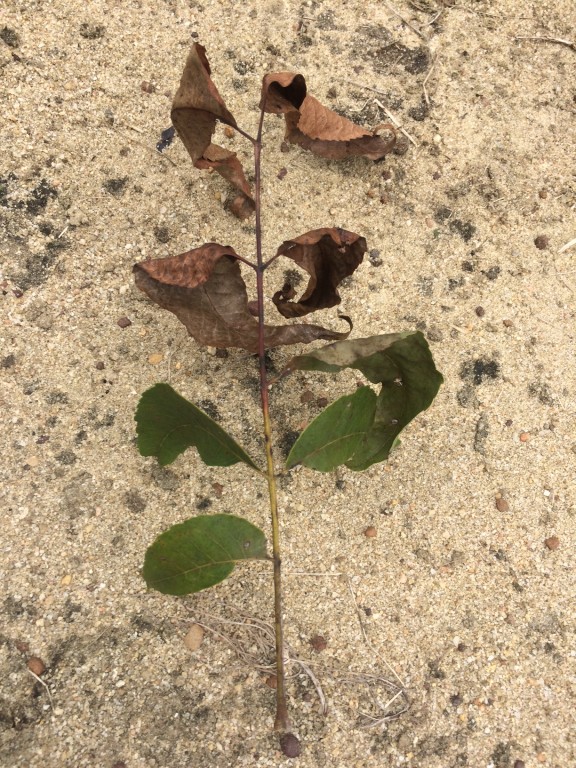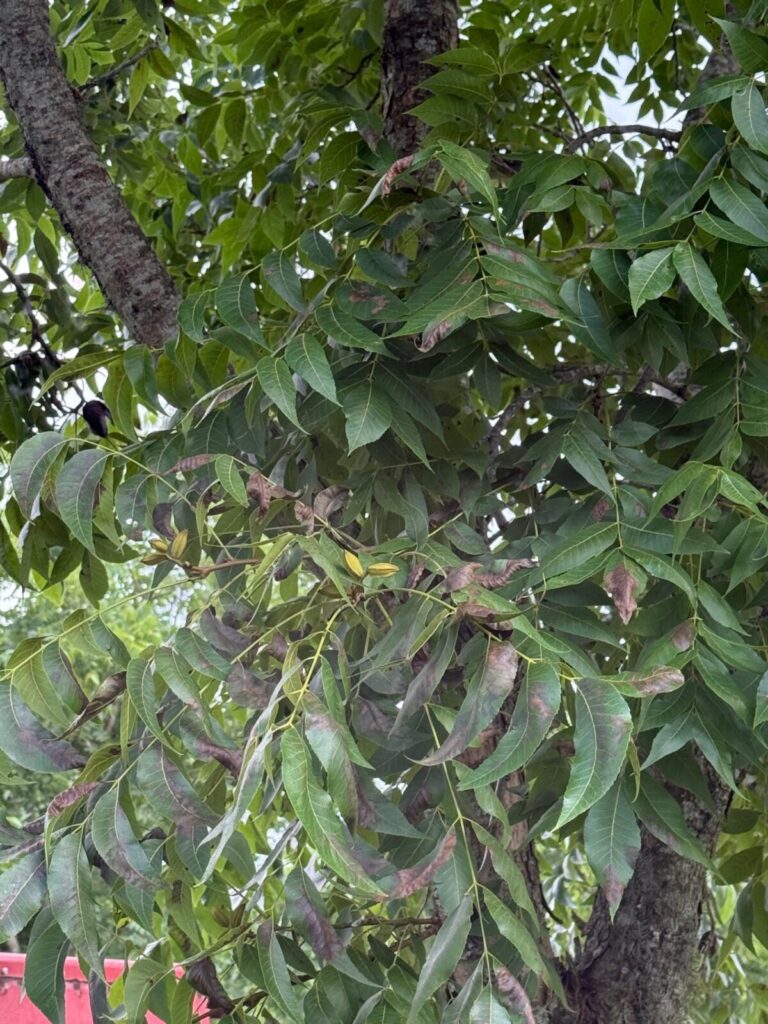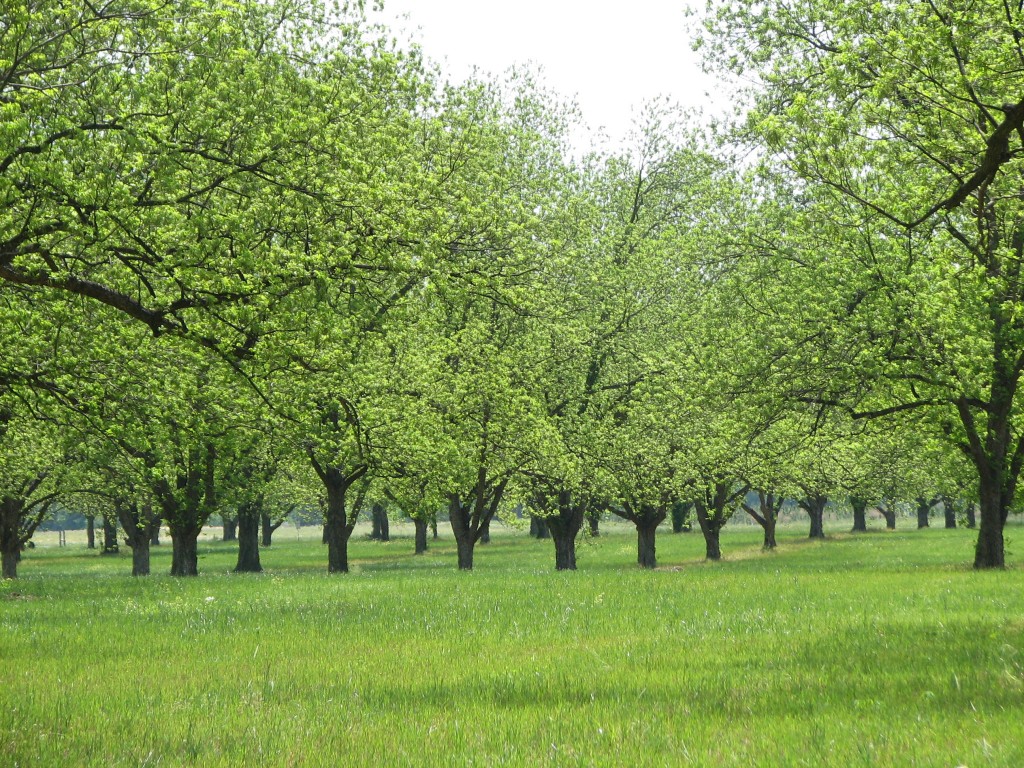Across Georgia the pecan crop looks good so far. I am hearing much the same from the other states. We are still in the midst of the June drop but nut set has been good overall. Surprisingly, nut set even in the hurricane damaged areas of East Georgia has been better than expected. This is difficult to explain since we almost always see a very small crop the year following a Hurricane in damaged areas. The only explanation I can see is that perhaps the storm happened early enough that we had a lot of regrowth and we had a late enough first freeze last fall to allow the trees in these areas to gather enough energy to make a crop. Our acreage in E. Georgia has been drastically reduced but the remaining trees seem to have a decent crop at this point. The question remains whether or not these trees will hold these nuts but they are doing ok so far. In the rest of the state, last year’s crop was good but not excessive, allowing most orchards to come back with a decent crop. I have heard of some older Stuart orchards that were heavy last year coming back with a very light crop this year.
A Word on The Upcoming Crop Estimates
With the Tri-State pecan meeting taking place in Mississippi later this week, we will see the first pecan estimates of the year coming out. Nothing against the folks making these estimates, but these estimates are all just wild guesses. Everyone familiar with them, including those making the estimates will tell you so. There are several estimates made through the year. The next will be Texas and then later in the season the shellers will make an estimate. Some of these estimates aren’t always far off and for most of them, the people making the estimates are talking with people throughout all regions of the U.S. pecan industry to get a reading on crop potential. But, all of these estimates are subjective and no matter what numbers come out, someone will be angry about it. To add to this problem, no one can say with any accuracy exactly how many acres of bearing trees we currently have just in Georgia. We had over 200,000 acres of pecans in Georgia prior to last year’s hurricane. I would think it is now back down to 150-170,000, not all of which are bearing. Nor can anyone say how many new acres of pecans will come into bearing this year or how many lbs the young acreage planted over the last 10-15 years will contribute. All of this makes predicting an accurate number for Georgia at least, almost impossible and is why I don’t provide numbers anymore. So, if anyone tells you “Lenny is going around saying Georgia has 150 million lbs” they are not telling the truth. I don’t know how many lbs we will have this year —and neither does anyone else. So, take all crop estimates with a grain of salt.
The APC/APPB is in the process of developing a more objective crop estimate model, which is being headed up by scientists at New Mexico State. It will take into account weather conditions, weather events, crop health status, previous year’s weather and crops, acreage, etc. and appears to show a lot of promise in my opinion. At the very least it will introduce some sorely needed objectivity into the industry’s crop estimates.
Disease Pressure
Scab pressure throughout much of Georgia has been tremendous over the last 2 to 3 weeks, with almost daily rains in some places making it difficult to get sprays on and keep them on long enough to provide the desired protection. That is making this crop more expensive to grow because growers are having to spray as often as every 7-10 days in some areas on highly susceptible varieties. Given all this, I have not seen as much scab out there yet as one might expect. It is there in places, mostly in the tops of older trees but not to the extent that we would expect given the pressure we’ve seen. I believe this is a testament to the fungicides we use now. From this point forward, Miravis Top and Dodine/Tin should be rotated for optimal nut scab control. The nuts are at their most susceptible point of the season and these chemistries have been proven in multiple years of Dr. Tim Brenneman’s scab trials to be the best options for nut scab control.
With all the wet weather, we’ve also had a lot of cloudy days and some temperatures cooler than normal in May. These were optimal conditions for anthracnose and Neofusicoccum. We are now seeing symptoms of both these diseases show up in some areas. Once they express symptoms you can’t make it go away but you could potentially limit further spread, so when conditions are right, it would be wise to include a phosphite in your sprays. The group 3 + group 11 mixes also have activity. Most people have been using phosphite and the group 3+11’s in April and May but that doesn’t mean it can’t show up. In fact, it would likely be a lot worse without them.
Both anthracnose and Neofusicoccum cause leaf necrosis but the patterns are distinctly different. Neofusicoccum is particularly distinct, with the necrosis beginning at the tip of the leaf and working toward the base as shown below, often with the leaf stem or rachis turning brown and necrotic as well.

Neofusicoccum symptoms on pecan leaf
Anthracnose also causes leaf necrosis but there is no set pattern. They appear randomly on leaves (edges, midrib, tip, base) and will often vary from one leaf to the next as shown below:


Anthracnose symptoms on pecan leaf
